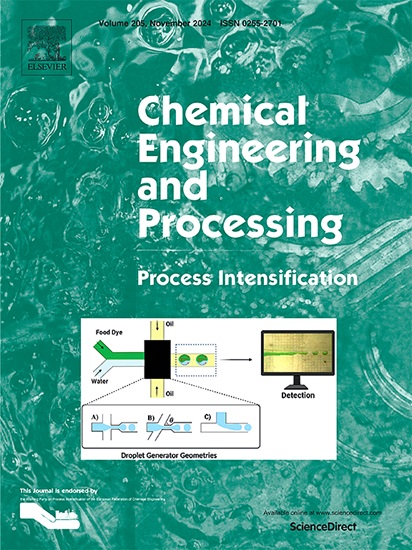Generation of high-viscosity heavy oil droplets: Insights from image analysis and numerical simulation
IF 3.8
3区 工程技术
Q3 ENERGY & FUELS
Chemical Engineering and Processing - Process Intensification
Pub Date : 2025-02-15
DOI:10.1016/j.cep.2025.110232
引用次数: 0
Abstract
To understand the behavior of high-viscosity heavy oil droplets generated in mass transfer systems, a method was established to measure the microdroplet formation via image analysis, with measurement errors controlled within 10 %. N-dodecane–dimethicone solutions with different viscosities and ethanol–deionized water solutions were employed as dispersed and continuous phases, respectively. The study identifies three stages of microdroplet formation: shrinkage, expansion, and fracture. The pressure and velocity fields during the fracture stage are simulated using a numerical simulation method. The fracture stages of droplets are categorized into three morphologies: fluctuating fracture, equilibrium fracture, and hysteretic fracture, which can be predicted using the Re number and We number. Increasing the viscosity of the dispersed phase increases the droplet formation time. The volume of produced droplets increases as the n-dodecane content in the dispersed phase increases. Finally, the droplet size decreases with an increase in the microdroplet formation time and a decrease in the nozzle size. Experimental results reveal the formation of high-viscosity heavy oil droplets in strong mass transfer solvents and offer prospects for developing micro-reaction technology for heavy crude oil refining.

高粘度稠油滴的生成:来自图像分析和数值模拟的见解
为了了解传质系统中高粘度稠油液滴的行为,建立了一种通过图像分析来测量微液滴形成的方法,测量误差控制在10%以内。不同粘度的n -十二烷-二甲基硅氧烷溶液和乙醇-去离子水溶液分别作为分散相和连续相。该研究确定了微液滴形成的三个阶段:收缩、膨胀和破裂。采用数值模拟方法对裂缝阶段的压力场和速度场进行了模拟。液滴的断裂阶段分为波动断裂、平衡断裂和滞后断裂三种形态,可通过Re数和We数进行预测。增加分散相的粘度会增加液滴形成的时间。随着分散相中正十二烷含量的增加,生成的液滴体积也随之增加。最后,微液滴尺寸随微液滴形成时间的增加和喷嘴尺寸的减小而减小。实验结果揭示了在强传质溶剂中高粘度重质油液滴的形成,为重质原油炼制微反应技术的发展提供了前景。
本文章由计算机程序翻译,如有差异,请以英文原文为准。
求助全文
约1分钟内获得全文
求助全文
来源期刊
CiteScore
7.80
自引率
9.30%
发文量
408
审稿时长
49 days
期刊介绍:
Chemical Engineering and Processing: Process Intensification is intended for practicing researchers in industry and academia, working in the field of Process Engineering and related to the subject of Process Intensification.Articles published in the Journal demonstrate how novel discoveries, developments and theories in the field of Process Engineering and in particular Process Intensification may be used for analysis and design of innovative equipment and processing methods with substantially improved sustainability, efficiency and environmental performance.

 求助内容:
求助内容: 应助结果提醒方式:
应助结果提醒方式:


